Supurbia #1 (Boom!, $3.99)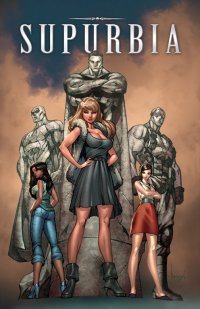
By Jeb D.
Some comics are too good to spoil.
OK, well, that’s true for a lot of things. And usually, when we talk about avoiding “spoilers,” we’re referring to mysteries, twists, secrets: the engines of plot development. In fact, the first issue of Grace Randolph’s new comic has barely any overt plot to it at all; it’s basically an introduction to the cast of characters: analogs of familiar superhero types and their families. Meeting those characters is where we need to leave the fun of discovery to the reader.
One of the reasons that superhero deconstruction has become a tired trope is that it too often relies on simply inverting the obvious, or just taking the piss out of the long-underwear crowd; too many writers feel that they’ve done their job by tossing in some “what if” situation that everyone else thought of long ago (“OMG-what if Superman and Batman were lovers???”) or having the good guys turn out to be assholes. Strong writers like Ed Brubaker and Kurt Busiek have done excellent work grafting other types of storytelling onto a superhero framework, but sometimes at the cost of the otherworldly scope of these godlike beings. Supurbia walks the line between those two by making the simple choice to use the wives, husbands, children, and friends of the members of the “Meta Legion” as the eyes through which we view the story… and when I say “simple,” I mean that it’s a clean and clear-eyed way to approach the story—that’s not the same thing as “easy.” Randolph carefully explores the implications of what it means to possess “great power,” as well as what’s involved in living and interacting with it. Everyone you meet in these pages is introduced quickly and efficiently, but in every case, the amount of care and out-of-the-box thinking that went into their creation is immediately evident.
And that’s where I need to leave this. Once the story is complete, I’ll probably look at the series again and try a more critical analysis. But the joy of this first issue is that feeling the reader gets, over and over again, of a perfectly-placed detail, a bit of dialog that tells more than you (or the character) would have expected, scenes that reflect Randolph’s sharp perception about the relationships of husbands and wives, parents and children, allies and rivals.
This is decidedly a writer’s book; that is to say, it’s largely dialog-driven and focused so far on exposition. But I’m not selling short the work of Russell Dauterman (with colors by Gabriel Cassata); his work leans to the cartoony (as opposed to Ale Garza’s tonally misleading cover), with the ability to craft a realistic range of facial expressions in just a few lines; he also executes the few visual gags effectively.
The last page of Supurbia introduces what will evidently be the main plot of this (first?) series, and it’s too early to tell if Randolph can move it forward without losing the insightful touches and grace notes, but based on the strengths of issue #1, there’s every reason to be confident. If this doesn’t turn out to be my favorite new series of 2012, then either Randolph will have completely failed to stick the landing… or, more likely, this will have been a fine year indeed.
Rating: 




Out of a Possible 5 Stars
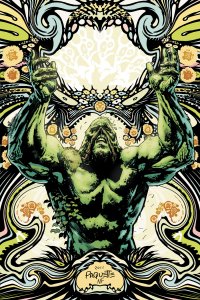 Swamp Thing #7 / Animal Man #7 ($2.99, DC)
Swamp Thing #7 / Animal Man #7 ($2.99, DC)
By D.S. Randlett
Remember when we were all kind of worried about Vertigo characters like John Constantine and Swamp Thing being reintegrated into the DCU? It seems absurd, now, especially in light of where these characters began. So much of the current comics culture and technique, even Vertigo itself, can be traced back to Alan Moore’s run on Swamp Thing. This run is rightfully legendary, and it firmly took place in the DC Universe, albeit its own unique corner. There was a bit of controversy when it came to Swamp Thing back then over its decidedly more mature content than most other DC Comics, and so Vertigo was born in an attempt to accommodate the period’s mostly British edgier writers like Moore, Neil Gaiman, and Grant Morrison. Of course, there were other factors besides the attempt to protect the family friendly DC brand (Karen Berger’s ambition, for one), but regardless, over time a bit of a schism developed between DC and Vertigo.
But the thing is, what’s so great about the DCU is that it can encompass something like Moore’s Swamp Thing or Gaiman’s Sandman. While there were some mighty fine comics to come out of that corner of the Vertigo imprint, I can’t help but feel like the mainline DCU lost some part of itself in that bargain. It is as if DC had split the unique, mature comics off from the “typical” superhero comics, in effect admitting that superhero comics could really only be one sort of thing. But the point of something like Swamp Thing was that the superhero genre had more to offer than what had previously been known. Despite its horror trappings, and despite most fans of the series attempts to label it as a horror book, Moore’s Swamp Thing still took things from the superhero idiom to accomplish its goals. That particular movement wasn’t seeking to tear superhero comics down, but rather to lift them up. Unfortunately, it seemed more prudent at the time for DC to just let it happen over there in the corner where Superman and Batman wouldn’t be bothered.
What a difference a few decades makes. The new Animal Man and Swamp Thing series are still taking place in what seems to be an isolated corner of the DCU, but it’s a corner that’s continually growing in scope and becoming more and more important. The reasons for this are the best ones possible: The creative teams on each book are tying the revelation of a certain corner of the DCU’s unique cosmology not merely into the status quo of the New 52, but rather into actual themes rooted in the book’s characters. The world building is quite good, and the implications as the parallel story lines in each series are headed for a collision (which I can’t freaking wait for), but Animal Man is first and foremost a story about Buddy Baker, Swamp Thing a story about Alec Holland.
Of these two particular issues, Swamp Thing is by far the strongest, but that may be more by dint of where the series is in its story than any of Snyder and Paquette’s relative creative merits. In the last issue, Abigail Arcane was taken away by the forces of The Rot, and Alec Holland was gravely injured. After denying his destiny to be taken by The Green, the Parliament of Trees has decided to prolong his death as The Rot conquers the Earth. I probably can’t spoil the big moment, but I suppose that I should refrain from saying anything more about the plot, but this issue manages to bring together a lot of thematic threads together in a really satisfying way. Swamp Thing and Animal Man have been developing into stories about man’s relationship to nature, with Swamp Thing having some much scarier tones. In it, The Green is an aspect of nature that wants to make Alec Holland serve it (whereas Animal Man seems to be developing into a story about coming to terms with a sort of internal aspect of nature), and the resolution in this seventh issue manages to combine the horror and tragedy of the Swamp Thing concept and the best horror stories with the fist pumping awesomeness of the best superhero stories.
But then, Animal Man is no slouch, but we’re at the beginning of a new arc rather than near the 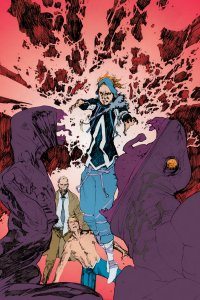 climax of one. So, it’s less exciting than Swamp Thing this month, but it manages to strike a different tonal balance than its cousin. Animal Man, for all of its horror elements, can be a rather sweet book about a family. There’s a really great scene where Buddy and his son stop into town to get some provisions while they are on the run from the forces of The Rot. While left to his own devices, the younger Baker tries to hit on some older girls who are obviously fans of his dad. Buddy comes to the rescue, so to speak, and I dare you not to smile. But then, I also dare you not to worry, as its still unclear exactly how safe the Baker family is. Also in this issue is a “Days of Future Past” style dream scene that shows what the world might be like if The Rot were to win, and hints at a larger destiny for the denizens of this corner of the new DCU.
climax of one. So, it’s less exciting than Swamp Thing this month, but it manages to strike a different tonal balance than its cousin. Animal Man, for all of its horror elements, can be a rather sweet book about a family. There’s a really great scene where Buddy and his son stop into town to get some provisions while they are on the run from the forces of The Rot. While left to his own devices, the younger Baker tries to hit on some older girls who are obviously fans of his dad. Buddy comes to the rescue, so to speak, and I dare you not to smile. But then, I also dare you not to worry, as its still unclear exactly how safe the Baker family is. Also in this issue is a “Days of Future Past” style dream scene that shows what the world might be like if The Rot were to win, and hints at a larger destiny for the denizens of this corner of the new DCU.
Sweet, tragic, scary, fun, and not at all cynical, Animal Man and Swamp Thing represent what superhero comics can be when they’re not afraid to get a bit weirder, scarier, and deeper.
Animal Man
Rating: 




Out of a Possible 5 Stars
Swamp Thing
Rating: 




Out of a Possible 5 Stars
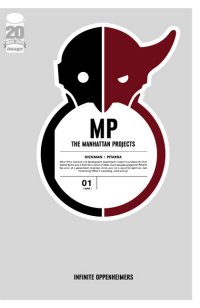 The Manhattan Projects #1 (Image, $3.50)
The Manhattan Projects #1 (Image, $3.50)
by Graig Kent
I’ve liked, even loved, most, if not all of Jonathan Hickman’s work over at the House of Ideas, but I still have the greatest affinity for his creator-owned work at Image. From Nightly News through to The Red Wing, each new Hickman original is like an event unto its own. One can typically expect big ideas, a healthy heaping of super-science, and varying portions of food for thought, and even if the story isn’t one hundred percent successful, the experience is always rewarding.
The Manhattan Projects launches as a speculative fiction of the “what if” variety, based around the Manhattan Project being used not only for atomic weapons research, but all-around fringe sciences development. Set in an alternate-reality 1942, it rather rapidly deviates from any grounded sensibility and into wilder terrain when a Japanese projectile hits the Manhattan Projects compound, and the dialogue starts bandying about terms like “telepaths”,”zen powered”, and “death buddhists”, not to mention the incursion of a few dozen diesel powered samurai robots.
The central figure of the book is “father of the atomic bomb”, Robert Oppenheimer and finds him being introduced to his new surroundings in what should be one of the worst first-day-on-the-jobs, ever, but it seems Oppenheimer is completely unfazed. Through a narrative montage, we learn that in this deviant world, Oppenheimer was a twin, his brother more interested in death and spirituality than science, becoming a serial murderer in the pursuit of his interest. One might see where this is going, but where it winds up is completely unexpected.
There’s a passing resemblance to the conceit of the Fringe TV series, in that manner of exploring surreal and extreme sciences like psychic powers, anachronistic technologies and alternate dimensions, but Hickman approaches it from his own trajectory. Much in the manner of his S.H.I.E.L.D. series at Marvel, he uses historical figures, Oppenheimer (and to a lesser degree, so far, Einstein) to both ground the story with something familiar and then launch it with the fantastical.
Hickman rejoins with his Red Wing artist Nick Pitarra, whose work appears more comfortable on the page. The characters are more broadly sketched than before, more cartoonish, but they have more character in them, in a Hergé-esque sense, more distinguishing features lending an immediate personality. Pitarra’s work involves a great level of detail illustrated in an uneasy line, an effect giving him a Geoff Darrow “junior”-like quality.
The Manhattan Projects isn’t a triumph out of the gates, and it’s not Hickman’s strongest work, but it’s certainly not boring, and the places it’s leading to are definitely unknown. In a landscape of retreaded ideas and familiar characters, it’s definitely worth sticking with.
Rating: 




Out of a Possible 5 Stars
HELL YEAH #1 (Image Comics, $2.99)
By Devon Sanders
Color me “interested.” Image Comics simply has become the place to be. Creators as incredible as Grant Morrison, Brian K. Vaughan and Ed Brubaker are lining up at Image, The House That Robert Kirkman Re-built, making it a destination spot for creators ready to try something new and do crazy things like own their ideas. Meanwhile, quietly, new creators have been shoring up the Image foundation with new properties and new takes on existing Image properties. Last month saw the relaunch of Rob Liefeld’s Glory, a character known pretty much not being Wonder Woman and something incredible happened; it was really good. Thanks to artist Ross Campbell’s brilliantly vivid re-imagining of Glory and the radical idea that she should inhabit a universe and not simply be a collection of pin-ups. Glory succeeded in no small part to writer Joe Keatinge’s tight scripting and with Hell Yeah #1, his new creator-owned work, he shows he’s a talent the comics industry should really keep an eye on.
Twenty years ago, superheroes only appeared within the pages of a comic book; that is until the day a young soldier finds himself near death and rescued by men and women who simply shouldn’t exist. A new Golden Age arrives and a new generation of heroes spawned. Fast forward 20 years and a young superhero finds himself and odds with society and himself. You see, he’s a superhero without a purpose and with a fiery crash, he’ll find himself drawn into something bigger than he and the world could ever have imagined.
Writer Joe Keatinge, as he did with Glory, crafts another comic that instantly draws you in and makes you want more through use of clever dialogue and the promise of something grander in the works. Artist Andre Szymanowicz perfectly captures these late teen characters, infusing them with a rebel spirit very much in line with the story’s dialogue.
Hell Yeah #1 is a comic full of promise and one well worth taking a look at.
Rating: 




Out of a Possible 5 Stars
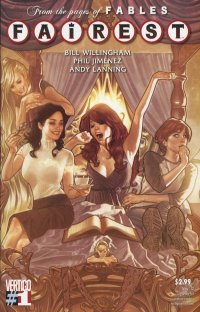 Fairest #1 of 5 (Vertigo, $2.99)
Fairest #1 of 5 (Vertigo, $2.99)
By Jeb D.
Fables is a title I read in trade, and I’m a few installments behind, so I was a little uncertain about jumping into this offshoot series—not so much that I’d be lost, as that I’d have missed the fun of getting to this point along with everyone else. If you’re in the same position, don’t worry: while I’m sure that the up-to-date Fables reader might be slightly ahead of you and me, the first issue of this series does have the virtue of not making you feel that you’ve been left out in the cold.
In fact, the story picks up more or less where “War and Pieces” left off a few years back, though we don’t find that out right away. Instead, we’re introduced to young Ali Baba, the Prince of Thieves, whose discovery of a magic lamp releases not a powerful d’jinn, but an elf-like “bottle nymph” with the unlikely name of Jonah Panghammer, and a personality that finds him the natural heir to predecessors like Pip the Troll, or Mr. Mxyzptlk. He’s part of the “Imperial Warlock Corps’ American Studies Program,” thus allowing him to confuse and annoy Ali Baba by his use of contemporary slang and speech patterns. He’s compelled to aid Ali in his search for treasure (“them’s the rules”), and his aid comes in the form of an avalanche of word balloons filled with smart-ass asides and pop-culture references (though the idea of living in a world where “Firefly” made it to seven seasons is certainly appealing). All their sneaking and skulking about (along with Ali’s rather talky encounter with a sword-wielding enemy) is gorgeously illustrated by Phil Jimenez and Andy Lanning, with colors by Andrew Dalhouse; if the rest of the series is this good, it’ll be career work from all three.
The result of Ali besting his foe appears to be the last-page awakening of the lovely redhead that he found sleeping (along with an equally fetching ash-blonde) a couple pages back; Fables readers will recognize her as Briar Rose, but it looks like it’ll be next issue before Ali gets to know her.
In fact, perhaps you’re looking at that Adam Hughes cover (or maybe you’ve already got the wraparound version as your computer desktop), and you’re wondering… uh, dude, where the women? A fair question. On the one hand, Ali Baba and Jonah are an amusing, if largely predictable, pairing. On t’other hand, this is a series which was being sold in advance as a bit of a showcase for several of Fables‘ strong female characters; in fact, there’s exactly one (full-page, I’ll grant you) panel in this issue that even features a woman who’s not unconscious. Here’s hoping that Willingham can do his women proper justice without slighting the story he’s begun telling, and without making either feel like a distraction from the other; my rating is largely based on future confidence that he’ll deliver the goods.
Rating: 




Out of a Possible 5 Stars